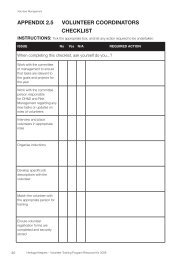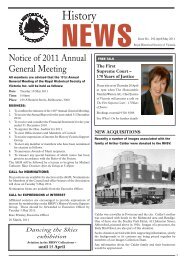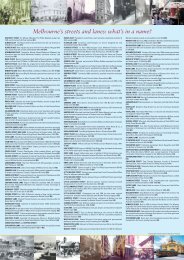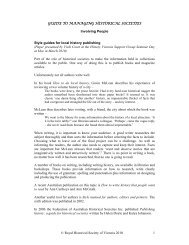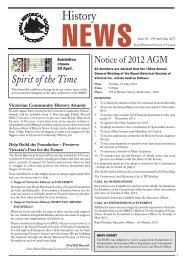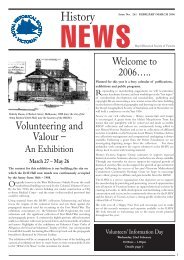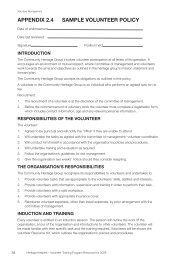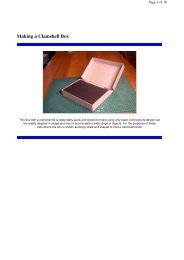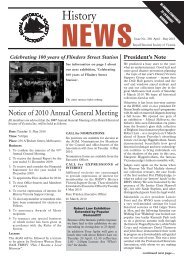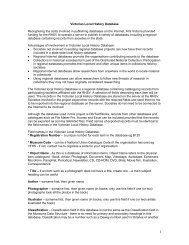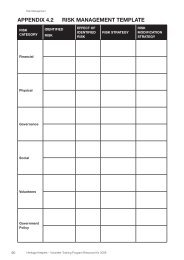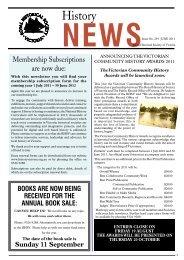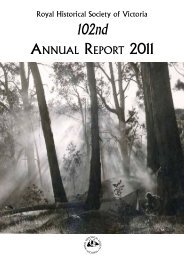Provenance - Significance - Preservation surveys - Royal Historical ...
Provenance - Significance - Preservation surveys - Royal Historical ...
Provenance - Significance - Preservation surveys - Royal Historical ...
You also want an ePaper? Increase the reach of your titles
YUMPU automatically turns print PDFs into web optimized ePapers that Google loves.
GUIDE TO MANAGING HISTORICAL SOCIETIESDeveloping a significant collection<strong>Provenance</strong>It is important to record the provenance of items (particularly artefacts), whenacquiring and cataloguing collection items. <strong>Provenance</strong> information can prove that anitem is authentic. Information collected for provenance includes who created and orowned the item and when and where it was made and (for artefacts) used. Thisinformation helps when determining the significance of the item and the importanceof the item for your collection. Fields are incorporated in cataloguing data structuresfor recording this information. A section for recording the information should beincluded in acquisition forms for new items.<strong>Significance</strong>Increasingly references are made to significance, significance statements andsignificance assessment in articles about collection management and in grantapplication guidelines.Some funding bodies expect societies to have had a significance assessment of theircollection before providing funding for collection management and other projects.Such assessments can be undertaken by an historian, a museum curator, a librarian oran archivist depending on the type of collection. The Community Heritage Grants –http://www.nla.gov.au/chg/ – from the National Library provide funding forsignificance assessments.Even if societies decide not to have an outside significance assessment made of thecollection, societies are still encouraged to internally evaluate the significance of theircollection. What makes the collection different from other collections? Do itemscollected fit in with the collection policy of the group? As well as looking at thesignificance of the collection as a whole, societies also investigate individual items,selecting the most significant items and providing a statement as to why they aresignificant. Considerations for significance may include rarity of the item, age of theitem and association with the local area. Some items and collections may be of stateor national significance. Information about the item’s provenance can assist whendetermining significance.In 2001 the Heritage Collections Council published <strong>Significance</strong>: a guide to assessingthe significance of cultural heritage and collections. This publication was revised andrepublished in 2009 as <strong>Significance</strong> 2.0 and can be downloaded from CollectionsAustralia Network website – http://significance.collectionscouncil.com.au/home .© <strong>Royal</strong> <strong>Historical</strong> Society of Victoria 2010 1
<strong>Preservation</strong> Surveys<strong>Preservation</strong> <strong>surveys</strong> examine the current condition of a collection and determine howitems may be preserved by preparing a prioritised list of recommendations forimproving the condition of the collection and the housing of collection items.Some funding bodies expect societies to have had a preservation survey of theircollection before providing funding for collection management and other projects.Such assessments can be undertaken by a conservator. The Community HeritageGrants – http://www.nla.gov.au/chg/ – from the National Library provide funding forpreservation <strong>surveys</strong>.© <strong>Royal</strong> <strong>Historical</strong> Society of Victoria 2010 2



